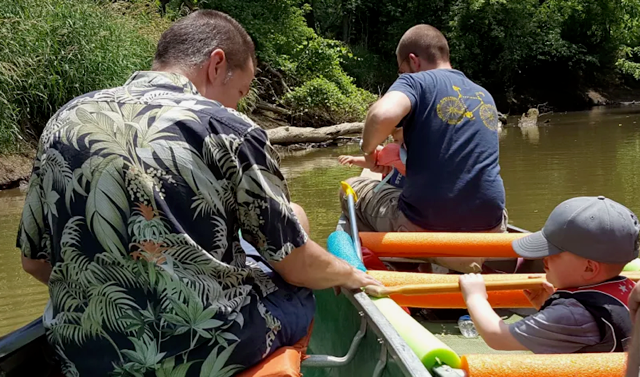Get kids into the canoeing groove - a step-by-step guide
Don’t hesitate to paddle young children.
I’m not talking about corporal punishment for toddlers; I’m talking about canoeing.
The most important thing to remember is you don’t want canoeing to seem like punishment. With a little preparation and planning, you can make it a safe and enjoyable experience for them. And yourself.
And you do want to come back with as many kids as you left with. That’s kind of important.
Life jackets are mandatory for children. And should be. Ohio law requires children under 10 years of age must wear a life jacket while aboard watercraft under 18 feet in length. That would include virtually all canoes and kayaks.
Adults must have life jackets in the boat but aren’t required to wear them. However, except in extremely low water conditions such as shallow streams with little current, it’s a good idea to wear a life jacket for two reasons − to set a good example and to be better able to respond in the event of a capsize or kid overboard situation.

Fit is important. Life jackets come in many sizes and styles. (In fact, manufacturers now make them to accommodate the adult female anatomy.) Generally speaking, youth life jackets come in three sizes − for children under 30 pounds, 30-50 pounds and over 50 pounds.
You probably won’t find life jackets for children under 30 pounds at your local department or sporting goods stores. They can be purchased online for store pick-up or home delivery.
Price ranges vary. Form-fitting life jackets tend to be more expensive − $40 and up − but it’s important to provide a life jacket children will want to wear in lieu of the cheaper, bulkier horse collar variety.
Beware and prepare for the elements
Paddling conditions are another safety concern − weather and water.
Don’t take young children out in less-than-ideal conditions. Rain and high wind can make for an unpleasant and potentially unsafe experience. Even on a warm summer day, getting drenched by a downpour can cause hypothermia, which can be fatal. For that reason, it’s a good idea to pack rain gear in case of an unexpected shower. And an extra change of clothing.
It’s equally important to prepare for sun exposure. Don’t forget hats and sunscreen. I also pack a salve, such as After Bite, to treat insect bites and stings. Hydration also is crucial, so make sure you take water or juice. Also, it doesn’t hurt to take along a little snack, if just to keep them entertained.
The less-than-ideal rule also applies to water levels and current. Even with a life jacket, a child can become trapped in a strainer (tree debris) or other obstacles.
In short, if the weather and river conditions aren’t agreeable, wait for another day.
A safety lesson his daughter learned the hard way
Create a safe, comfortable environment inside the canoe. I learned this lesson the hard way. Actually, it was my daughter who learned this lesson the hard way. On her first canoe trip, we bottomed out on a gravel bar. The canoe came to an abrupt stop. She didn’t.
Foam rubber noodles protect kids from banging their heads on the thwarts and gunwales.
Since then, whenever canoeing with children, I pad the thwarts (crossbars) and gunwales (side rails) with pipe wrap. Better yet, use hollow-core foam “noodles.” They provide more padding than pipe wrap and come in bright colors, which makes them more appealing to kids. (And easier to find if end up in the river.) Cut the noodles to size, slit them lengthwise and slip them over the thwarts and gunwales.
A yoga mat placed on the floor of the canoe provides better footing and comfort for children. My daughter found hers very tasty, judging from the bite mark she left on the edge of it. (Note to self: Next time pack more kiddie snacks.) Yoga mats can be somewhat pricey. Higher-quality ones run $30 or more. But, when not lining the floor of the canoe, they can be used for other purposes − such as yoga.
Kids need paddles they won't use, put wading and stone-skipping on the agenda
Finally, canoe trips should be tailored for children’s brief attention span. They won’t be as enthralled as you are with the scenery and wildlife.
I recommend providing child-sized paddles. Most kids, especially younger ones, won’t use them much. Except perhaps to resolve sibling rivalries. To kids, dipping a paddle in the water is like fledgling birds testing their wings; they aren’t ready to fly, but they will begin to get the feel of it.
More importantly, stop along the way to wade in the river and skip stones. While you’re at it, collect large quantities of “balooking stones,” so called because of the sound they make when they hit the water. Children enjoy tossing stones into the river and you’ll probably find yourself making frequent stops to replenish their supply.
When your children get to the age when they stop throwing “balooking stones” in the water and throw them at you instead, it’s probably time to buy them their own canoe or kayak.
This article originally appeared on Ashland Times Gazette: Canoeing with the kids - a fun adventure with a little planning

